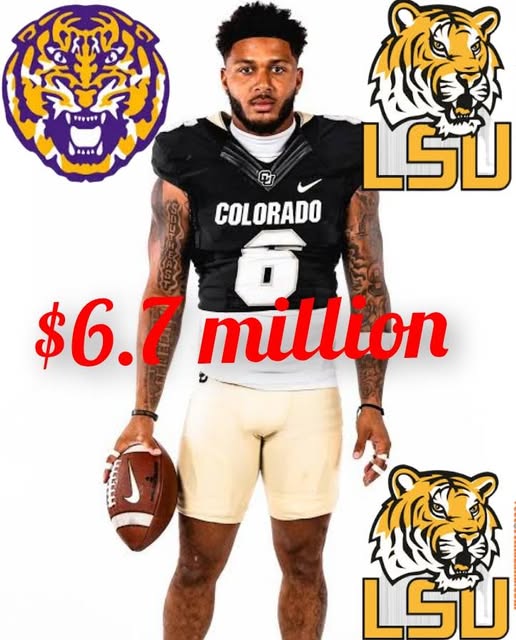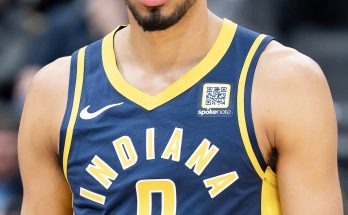In an era where college football recruiting is not only defined by tradition, legacy, and championship aspirations—but now, undeniably, by the booming market of Name, Image, and Likeness (NIL) opportunities—the decision of a top-tier high school prospect can ripple across the nation. That ripple became a tsunami this week, when a five-star quarterback stunned the college football world by declining a reported $6.7 million NIL package, decommitting from Deion Sanders’ Colorado program, and flipping his commitment to Brian Kelly and the LSU Tigers. His decision came after months of speculation and a fierce recruiting battle involving Notre Dame and Florida State, two storied programs that now find themselves on the outside looking in.
The move marks one of the most significant and shocking commitment flips in recent memory—not simply because of the player’s talent, but because of what he turned down in the process. The quarterback, who has quickly ascended to the top of national recruiting boards with his combination of arm strength, mobility, and poise under pressure, was widely seen as the crown jewel of the 2025 recruiting cycle. At 6-foot-4 and 215 pounds, he possesses every physical and mental tool to lead a Power Five program to national prominence. But the statement he made in choosing LSU transcended football—it was a decision rooted in vision, belief, and culture, rather than cash.
Recruiting insiders had long pegged Colorado as the frontrunner in his recruitment, especially following his glowing remarks about Deion Sanders’ leadership and the program’s commitment to innovation and exposure. In an age when social media metrics and branding value can be just as alluring as offensive schemes, the Buffaloes had been in pole position, reportedly offering a deal that included a mix of endorsements, business partnerships, and long-term revenue-sharing opportunities. The $6.7 million figure, though not confirmed by the player’s camp, had become an open secret in NIL circles.
But behind the scenes, doubts had begun to simmer. While Colorado has made undeniable strides under Coach Prime, including a massive spike in national relevance and recruiting buzz, questions about on-field results and long-term stability in Boulder may have contributed to the quarterback’s change of heart. LSU, by contrast, offers a well-established SEC platform with a proven developer of quarterbacks in Brian Kelly, a rabid fanbase, and one of the richest talent pipelines in the nation. The Tigers didn’t flash the biggest check—but they made the biggest impression.
Sources close to the recruitment indicate that LSU’s pitch centered on development and legacy. Kelly and his staff emphasized the recent success of LSU quarterbacks—like Joe Burrow, whose Heisman season and national championship run remain fresh in the memory of college football fans. They showcased a vision in which the quarterback could become the face of a program with national title aspirations, while also building a future that included NFL preparation and smart, long-term NIL growth rather than immediate payday gratification.
Perhaps most impressively, LSU resisted the temptation to engage in a financial arms race. They trusted their program’s appeal and their track record of success to win over the quarterback and his family. In doing so, they secured a player who could very well change the course of the next three seasons in the SEC.
For Notre Dame and Florida State, the runner-ups in this recruitment saga, the news is undoubtedly a blow. Both programs had invested heavily—emotionally and strategically—in his recruitment. Notre Dame, with its iconic status and blend of academics and athletics, had offered a compelling pitch centered around legacy, leadership, and becoming the next great signal-caller in South Bend. Florida State, with its recent resurgence and dynamic offensive schemes, presented a clear path to early playing time and a return to national prominence.
But in the end, none of it was enough to match the combination of stability, opportunity, and intangible cultural fit that LSU offered. According to insiders, it was a quiet visit to Baton Rouge earlier in the spring—one that was largely kept out of the media spotlight—that shifted the tide. There, he reportedly bonded deeply with players, engaged in a candid sit-down with Brian Kelly, and left with the sense that LSU was more than a stepping stone to the NFL—it was home.
The quarterback’s high school coach, speaking on condition of anonymity, offered rare insight into the decision. “He’s not your typical five-star kid chasing flash or short-term glory. He’s thinking three steps ahead. NIL is great, but what he wants is a place that will challenge him, protect him, and prepare him for the league. LSU made that case without pushing a number across the table.”
As for Colorado, the loss is not merely about missing out on a generational talent—it raises questions about the balance between hype and substance in modern recruiting. Deion Sanders, for all his charisma and recruiting magnetism, is now facing the reality of high-profile losses. While he’s certainly landed his fair share of blue-chip prospects and elevated Colorado’s national profile, this decommitment will sting. The optics of a player turning down nearly $7 million to leave a program that markets itself as the future of college football will be tough to spin.
However, it’s also a reminder that in this NIL-driven era, not all players are driven by money. The narrative that the richest offer automatically wins has been disrupted. This quarterback’s move to LSU sends a powerful message to fellow recruits and fanbases alike—that fit, tradition, and development still matter. In fact, they may matter now more than ever.
There’s also a deeper cultural resonance to this flip. LSU is not just gaining a quarterback—they’re getting a leader, a national face, and a future first-round pick who spurned the bright lights and big money in favor of a grind-it-out SEC path. The fans in Baton Rouge understand quarterback excellence, and now, they have a new icon-in-the-making to rally around.
In the short term, this decision will reshuffle the 2025 recruiting landscape. LSU now vaults to the top of several recruiting class rankings, while Colorado’s class takes a hit. Notre Dame and Florida State will undoubtedly redouble their efforts to land top alternatives, but their staffs will have to regroup after falling short of landing one of the most coveted players in the country.
The ripple effects may also impact the transfer portal, where quarterbacks often look to find greener pastures once depth charts shift. With LSU’s quarterback room now set to gain a new alpha, it wouldn’t be a surprise to see current or potential LSU targets reevaluate their positions. And while the young star is still months away from setting foot on campus, the pressure and expectations have already begun.
He’ll arrive in Baton Rouge not only as the highest-rated quarterback to commit to LSU since Burrow transferred from Ohio State—but as a symbol of what college football still can be. Not just a business. Not just a paycheck. But a sport built on tradition, passion, and the pursuit of greatness.
And that’s what makes this story more than just a headline. It’s a turning point.
Because when a teenage quarterback says no to $6.7 million and yes to a team he believes in, it reminds us all why we fell in love with this game in the first place.



